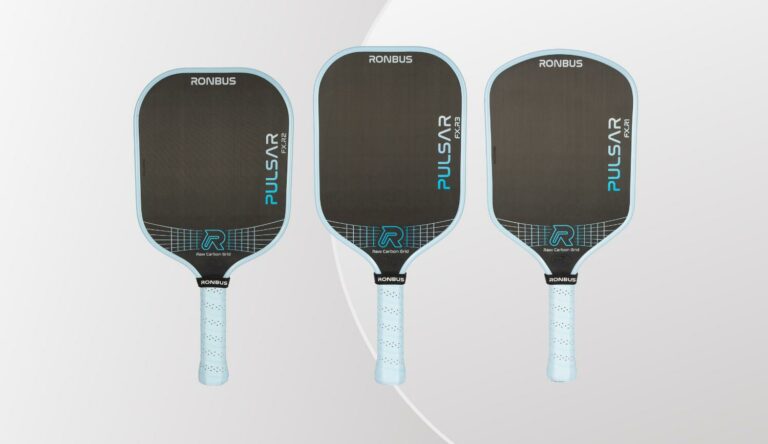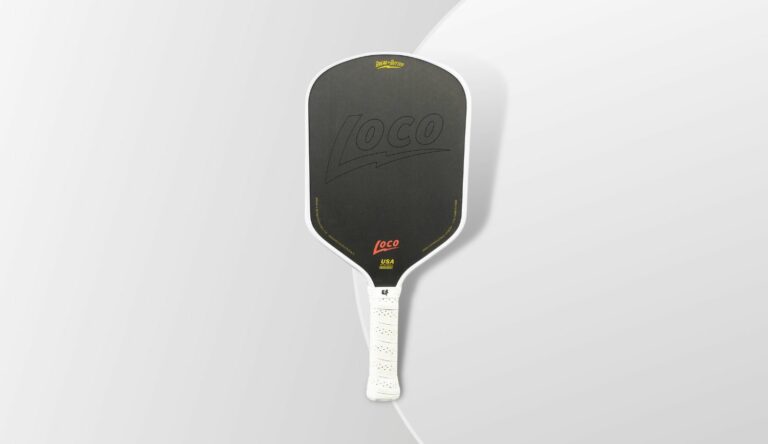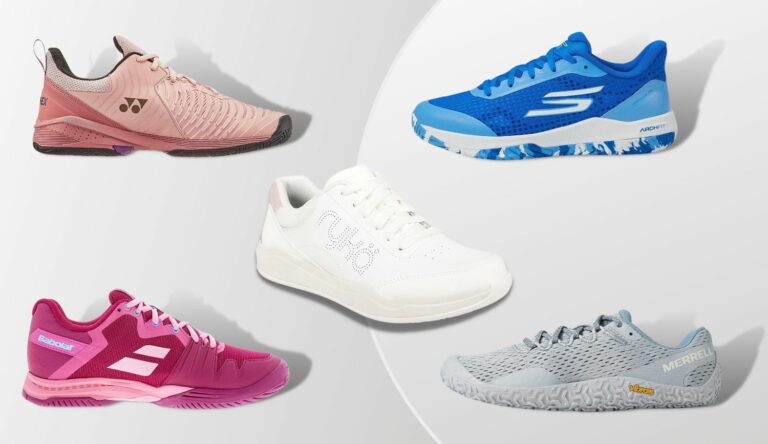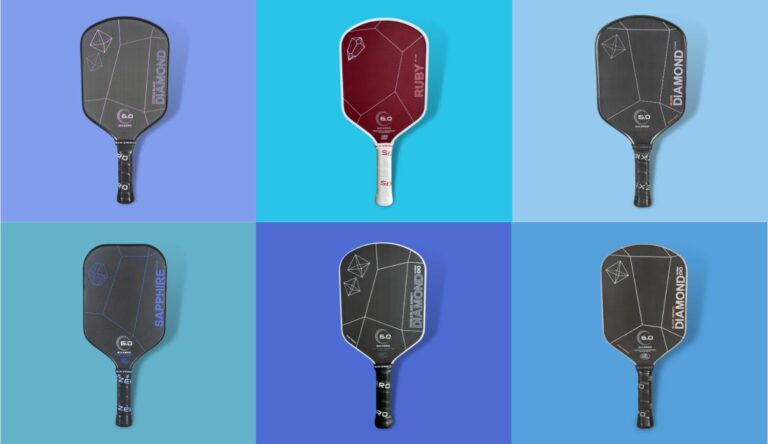Struggling to find the right pickleball paddle that balances your unique needs and wants? Maybe you’re just curious about new tech and might want to add another great paddle to add to your arsenal.
The original hyper-elongated Pro Line Energy paddle really impressed me and has shown to be an ideal paddle for a particular type of player. The release of the new Pro Line Energy S is meant to fill needs for an even broader type of players.
Whether recreational or aspiring pro, this could be the right paddle for you. Read on to learn in-depth about this unique hybrid Kevlar-faced paddle and how it sets itself apart from the competition in regards to performance and value.
Contents
Pro Line Energy S Technical Specifications
- Price:
$152.99($137.70 with Discount Code: DASHPB) - Shape: Hybrid (between elongated and square)
- Core: Narrow-cell Honeycomb Polypropylene
- Core thickness: 16.5mm
- Face: Dynamic Kevlar (blend of Kevlar & Carbon fiber weave)
- Handle length: 5.5″
- Grip circumference: 4.25″
- Average weight: 8.0 -8.4 oz
- Swingweight: 118-120
- Thermoformed: Yes
- Total length: 16.4″
- Width: 7.6″
Add Discount Code DASHPB at Checkout
Quick Summary
The Pro Line Energy S stands out with its unique paddle surface tech, like its predecessor, the original Pro Line energy. Where the new S model differs is in its shape.
The Pro Line Energy S paddle has a similar hybrid shape to popular paddles like the Six Zero Double Black Diamond, Ronbus R1.16, R1 Pulsar, R1 Nova, Vatic Pro Flash Prism, and Volair Mach 1 Forza paddles. These paddles all share an aero-curved top. However, it’s dimensions differ in a few key ways:
- It’s 0.5mm thicker than typical paddles
- It doesn’t have the flared shape at the top corners like the Vatic Flash and Six Zero Double Black Diamond.
- It’s slightly longer by 0.1 inches compared to most hybrid paddles
The major feature that sets this hybrid thermoformed paddle apart from the pack is its unique surface technology. Instead of just carbon fiber, it uses an interwoven blend of Kevlar and carbon fiber. The carbon fiber provides responsiveness and spin, while the Kevlar increases durability and provides a softer, more muted feel.
This introduction of Kevlar surfacing is definitely not a gimmick. The result is a paddle that provides an excellent combination of power, control, and a softer feel compared to traditional carbon fiber thermoform paddles.
It doesn’t have quite as much pop as most thermoform paddles, but it makes up for it with increased control and great spin numbers. The paddle feels excellent for touch shots while still having enough thermo-driven power for hard serves, drives, counters, and putaways.
The shape is easy to maneuver while retaining stability from the extra thickness and weight distribution. It also looks compelling with the unique grid-patterned surface.
For the price, it’s a pretty outstanding paddle. Regardless, there’s a lot of competition in the hybrid-shaped thermoformed paddle space right now. So, let’s look closer to how it stacks up to the competition.
Feel
Handle
The Pro Line Energy S paddle uses a fairly standard handle shape with a circumference of 4 1/4 inches. Nothing out of the ordinary, which isn’t bad because this handle shape is solid. The octagonal contour is comfortable in my hand.
At 5.5 inches, the handle provides enough space for two-handed backhands. It also tapers up, allowing you to choke up slightly and gain an extra 1/2 inch of reach.
The grip feels smooth and absorbs moisture well enough during extended play. The only downside is it can get slippery when wet. Adding an overgrip resolves this issue.
Weight & balance
Weighing between 8.0 and 8.4 ounces, the Pro Line Energy S sits around the middle or slightly above average compared to other hybrid paddles.
Due to the extra 1/2 inch of length and thicker core, the balance sits further towards the head. It’s not overly head-heavy, though. I like the added control from the extra .5 thickness of the core. It adds some stability without wrecking maneuverability.
How it feels impacting the ball
The hybrid Kevlar/carbon fiber surface creates a plush yet responsive feel when contacting the ball. It doesn’t have the crisp pop you might be used accustomed to from other thermoforms, but the paddle still transfers plenty of force and spin.
The more muted impact helps with control for touch shots, resets, and blocks near the net, where softer contact is beneficial. The ball dwells on the surface just long enough to allow you to carve angles and add plenty of spin when desired.
I’ve noticed that the muted sensation also reduces vibrations, which limits potential arm stress compared to stiffer paddles.
Power
The Pro Line Energy S has less power output than most Gen. 2 thermoformed paddles. This is because its thicker core and hybrid Kevlar face create a softer, more muted touch with increased dwell time.
Despite it being a slight notch behind other thermos in power, it’s still thermoformed. I’ve found it easy enough to put pace and depth on my shots, especially deep drives and serves. My serves clocked in at about 51mph, which keeps it in the thermoformed range of potency.
The slightly more elongated hybrid shape and thicker core help put pace on more off-center hits. However, it is a bit harder to put power and pace on balls at the net due to its lack of pop and increased dwell time.
Slower-paced strokes will definitely hit harder and perform better than quick power shots with this paddle. I prefer the Energy S for these types of shots over most thermoformed paddles. My Ronbus R1 Nova is a stiffer thermo, but the Pro Line Energy S delviered more power than it on these type of shots.
Pop
The Pro Line Energy S doesn’t quite match the pop output of many Gen. 2 thermos. Some pop must be sacrificed for it to embrace its softer Kevlar-faced identity. It’s one of the least poppy thermoforms I’ve played with. It definitely has less pop than softer thermos like the Ronbus Pulsar line and even less than the newer Six Zero Infinity Double Black Diamond.
That said, it’s no slouch, either. It’s still a unibody thermoformed paddle, so by its nature, you get a stiffer and more rigid pop off of the paddle compared to non-thermoformed paddles.
Overall, the Pro Line Energy S offers better touch and control compared to most thermo paddles but still provides exceptional pop performance for a more muted paddle. The ball comes plenty fast enough to catch opponents off guard.
Control
With its hybrid Kevlar surface, the Energy S is one of the most controllable thermoformed paddles I’ve played with. It lands in similar territory as other control-focused thermoforms, such as the Ronbus R1 Nova and Six Zero Infinity Double Black Diamond. But I think it’s more controllable than them due to that softer, more muted feel of Kevlar, which gives it great dwell time and directionality.
Compared to stiff carbon paddles that launch the ball too sharply, the Energy S allows you to shape angles with finesse while retaining responsiveness. The muted feedback also means off-center hits stay more accurate compared to rigid carbon faces. My game felt controllable with this paddle across all facets of my play – from drives, blocks, serves, volleys, etc. I’ve played around with addeding additional weight on the edges via lead tape near the bottom of the paddle face for more stability and plushness.
That said, the Energy S is still a controllable thermoformed paddle, not a pure control paddle. So power and spin are still more impressive than its control performance when compared against true control paddles. It’s forgiving but not as easy to get totally dialed in with.
Spin
The Pro Line Energy S is in the top-tier category of paddles with high spin output. Pickleball Apes stated the newer S model exceeds even the original model in spin output due to further texturing optimizations that maximize performance. I was able to achieve rotations of over 2,000 RPM in my tests.
It’s a great paddle to learn spin shots with and for intermediate/advanced players to optimize their spin game. It’s an extremely grippy paddle that requires minimal effort to apply spin.
That said, you might not get quite the spin output as a Six Zero Black Diamond, Volair Mach 1 Forza, or Bread & Butter Filth with the Energy S than those pure carbon-faced paddles.
Hand Speed/Maneuverability
This is an area in which the Pro Line Energy S outperforms the original elongated Pro Line energy. The shorter, wider hybrid frame helps with fast reactions, especially for counters, blocks, and speed-ups. I didn’t find it challenging to react quickly to speed-ups or change direction quickly.
Compared to other Hybrid paddles, the Pro Line Energy S is slightly slower in hand than most that I’ve played with. I can attribute this to the thicker core and slightly longer length that gave it a bit more head heaviness. The perk here is that stability is good, so you don’t need to lean into lead tape for support.
Durability
Like all Gen. 2 thermoformed paddles, the durability story of the Pro Line Energy S centers around its resilience to delamination, disbonding, and core corruption. These issues plagued early thermoformed paddles and caused quite a stir.
So far, I haven’t experienced any of those issues with either of my Pickleball Apes paddles, and I haven’t heard anyone else having these problems, either.
Delamination-type issues aside, the thermoforming production method makes a durable paddle that will withstand stress. Since it’s unibody, you won’t get breakage issues where the handle connects at the neck. So you’re covered there.
The last big question about the durability of this paddle is how the surface holds up. Pickleball Apes has said their hybrid Kevlar surface material will hold up better than pure carbon fiber. Time will tell, as this paddle hasn’t been on the market long enough to fully evaluate surface durability over time. So far, early testing looks good.
Value
This paddle is a great deal at $137.70 with code DASHPB. The Energy S is tops in quality, innovation, and unique thermoformed playability. It hits the sweet spot between price and performance.
By comparison, the name brands’ $200-280 paddles don’t add more in performance or innovation to justify their higher cost.
What Type of Player is the Pickleball Apes Pro Line Energy S Best For
The right player for this paddle wants more power than a non-thermoformed paddle but doesn’t want to sacrifice controllability. It’s great for beginner to intermediate players who want to test the waters of thermoforming.
This type of player prioritizes control/feel to develop their skills confidently while still retaining decent offensive abilities. They also want top-tier spin performance and a maneuverable, hybrid shape.
The Energy S is also a great match for any player who wants to test out new paddle tech. Pickleball Apes is a first mover in this space with their hybrid Kevlar paddle face.
For me, I found that dinking, in particular, felt better than most thermos. But the dwell time and lack of pop made baseline drives feel a little different, which took some getting used to. The limited feedback can require some adjustment before you get really dialed in with your drives and touch shots.
Add Discount Code DASHPB at Checkout
How the Pro Line Energy S Paddle compares to the original Pro Line Energy Paddle
The original elongated Pro Line Energy paddle makes better use of its longer surface area for extra reach and whippy power. It excels for aggressive baseliners seeking pure speed and plow-through.
However, the longer length sacrifices some control and quickness during reactionary exchanges at mid-court and the kitchen line. The narrow hitting zone also requires precise timing that could frustrate progressing players initially.
The Pro Line Energy S uses more standard and familiar dimensions that gives most players a little more confidence with swings and transitions. It has that great hybrid maneuverability and control while holding its own power-wise still.
So while the OG model focuses more narrowly on reach and whip, the S version is more versatile and at the net and more familiar in hand, which makes it appeal to a larger audience.
In closing, I really like the Pickleball Apes paddles so far. Other Paddle companies should pay attention to Pickleball Apes’ paddle releases, as these paddles innovate and perform well.
Add Discount Code DASHPB at Checkout
Keep Reading:
- Best Pickleball Paddles for Beginners
- Best Pickleball Paddles for Intermediate Players
- Six Zero Double Black Diamond 16mm Review
- Six Zero Infinity Double Black Diamond Review
- Vatic Pro Prism Flash 16mm Review
- Ronbus R1 Nova Review






